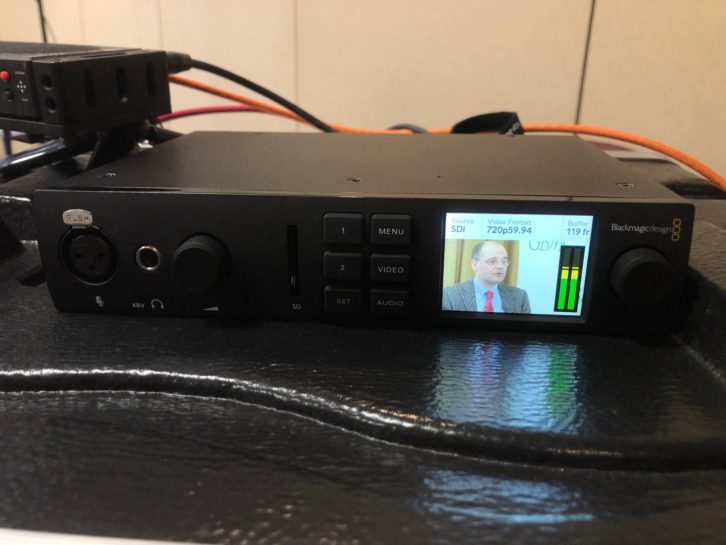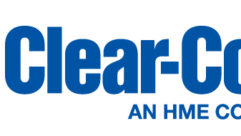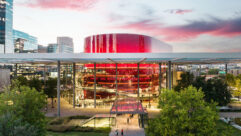On this edition of the SVC Podcast, Contributing Editor Bennett Liles talks with Marty Jenoff, President of Focal Point Productions, about the their partnership with Greater Baltimore Medical Center and the new global emphasis on videoconferencing technology. Focal Point has recently produced a series of town hall meetings to provide up to the minute information on Covid-19 to hospital staff and administrators. He also discusses a number of Facebook live streaming programs you may find helpful.
FOR MORE: GO TO PART 2
Links:
- Focal Point Productions in Owings Mills, Maryland
- Blackmagic Design’s ATEM Television Studio HD
- Blackmagic Web Presenter
- Decimator Design MD-HX HDMI / SDI CROSS CONVERTER
Coming up on the SVC Podcast, the Covid-19 pandemic has hit the medical community hard and real time information exchange is vital. Focal Point Productions put their expertise in videoconferencing to work to make that happen for Greater Baltimore Medical Center. Company president Marty Jenoff has the story on how Focal Point put it all together.
Marty thanks for getting with us on the SVC Podcast.
Thank you for having me.
Yes, coming to us from the Baltimore area.
Yes, yes. Baltimore County just outside of the city.
Alright and president of Focal Point Productions.
Yes, sir.
And before we get into your video conferencing projects for Greater Baltimore Medical Center, tell us about Focal Point Productions.
So I got my start in video production at the age of 13 when I started doing for fun some friends’ parties and weddings. And my passion for video continued through high school and college, and when I graduated from college in 2000 I started Focal Point Productions with three other friends. Over the first couple of months they kind of got out of the business and pretty quickly it was just myself. And when I started in 2000 it was mostly weddings, social events, not too many corporate events. And then in 2008 when the economy tanked because of the housing market the first thing to get cut from every wedding or party was video. But lucky for me that’s around the time when Facebook and YouTube started to come out and when customers wanted video for their websites. So I started doing corporate work in 2008 and in 2011 I started dabbling in livestreaming and webcasting where now all I do is corporate events. No more social events; that stopped about six years ago. I do all corporate jobs and livestreaming is a huge chunk of my business. [Timestamp: 2:08]
And how would you have known way back then that we would be in the situation we have now and suddenly people have few other ways to connect? What has Focal Point’s response to the coronavirus outbreak been?
Just before the coronavirus hit work was really busy for us. We had a lot of livestreaming jobs and corporate jobs for the rest of March, April was booked, May was really busy. We were going to have a great couple of months. But once the coronavirus hit everything got canceled. All of our jobs got immediately cancelled, but I got an enormous amount of enquiries about livestreaming. I got more phone calls and more emails about livestreaming in four days than in the last six months. [Timestamp: 2:54]
Yes, that’s incredible.
Yeah. I mean, like you said livestreaming is now the only way for people to be in contact whether it’s using Zoom or Skype or WebEx or Facebook Live. That’s really the only way for companies to have – for meetings, for businesses to talk to their customers or their clients in a quick, time-efficient manner. So we’ve done several livestreams for one of our clients, which is Greater Baltimore Medical Center, GBMC, which is in Baltimore County. They’ve been one of our clients for a long time and we’ve done livestreams for them before. And they reached out to us pretty quickly about helping them to communicate with the community and to communicate with their employees as well. [Timestamp: 3:40]

Certainly there can’t be a higher calling than that right now because they’re the people on the front lines. You teamed up with the Greater Baltimore Medical Center so what have you been doing to help their people communicate?
So one of the first livestreams that they wanted our help with was to do a leadership town hall. To have the president of the hospital, the Chief Medical Officer, head of Human Resources, their Infectious Control Disease Manager to do a town hall so that those people could talk directly to the nurses, the doctors, all of the staff of the hospital. They wanted to do a Q&A to kind of tell them where are we now? This is what’s happening. This is where we think it’s going to go. And then answering all of their questions. So we did this first one right as things started and this hospital system has 4,000 employees. And with very little notice our livestream had more than 600 viewers. So about 15-20 percent of their workforce tuned in to watch. We did our third one and had over 1,000 people watch. More than a quarter of the employee workforce tuned in to watch live to hear what was happening. [Timestamp: 4:58]
And one of the very special things about this is, since it’s live you can get them right up to the minute information and listen to their reactions and get the give and take between those providing the information and the medical workers making use of it. No substitute for live interaction at a time like this.
Yeah. So our client decided to use Cisco’s WebEx for this. They have a great chat feature. So we probably received dozens and dozens of questions and comments from employees watching and the moderator was able to follow along and was able to direct those questions to the proper person immediately. So we were able to answer so many people’s questions right then on the spot only because we were doing it live. [Timestamp: 5:43]
Well, you’ve been in this at the professional level for a while. What do you think when you see so many people trying to get into videoconferencing of some kind almost overnight?
Like you said I’ve seen tons of examples of people trying to do their own livestreams, whether it’s you seeing it on the nightly news interviewing experts or even hosts or reporters in their homes using their own setups, or more professional setups like we did for GBMC. But more often than not a lot of what I’m seeing, people are doing it wrong. And a lot of the things you can do to make livestreaming look good, they can be pretty easy and they can be pretty inexpensive, but I’m not seeing people do it mostly probably because they just don’t know any better. [Timestamp: 6:31]
Yes, usually there’s no way for them to hear how they really sound and a lot of things they do that are really distracting, they don’t even notice. At least not unless they eventually get to see the recorded video.
Yeah. Audio is a really big thing where people are using the built-in microphone on their laptop computer, which is probably 12 to 18 inches away from their mouth so it sounds really bad. They’re using their laptop’s built-in camera, which is a tiny, tiny little thing which doesn’t do really well and so the image is bad. And then when you add the fact in that the camera is below their nose, so the camera is looking up and all you can see is people’s nose hairs and you can see their chins and you can see the ceiling of wherever they are. The lighting is bad. I’ve seen so many bad examples, but it only takes a couple of simple tips to improve that quality. [Timestamp: 7:25]
I’m sure most people are going to get better at it as they get used to using the various conferencing applications. But the live town hall meetings aren’t the only things you’ve been doing for Greater Baltimore Medical Center.
The one other thing that we did for GBMC in addition to the town halls, we did several Facebook Live broadcasts. In two days we did five Facebook Lives for the hospital for the community on different topics around Covid-19. So we did one about anxiety and depression. We did one on heart health. We did one on diabetes. We did one on just answering common questions related to the disease – to the virus; how you can protect yourself and things like that. And then we did one on the hospital’s obesity weight loss program. We did a livestream for them as well. So we did the town halls, which were just for internal employees and then we did the Facebook Lives which were for the community in the whole. [Timestamp: 8:22]
And those are two different animals. Most people know how to use Facebook but that’s probably more of a one-way situation. On the town halls you’ve got people speaking freely from all points and you probably never know who’s going to talk when.
Yeah, true. We did have that issue, but we did use a very similar setup for both. We use multiple cameras. We use anywhere from two to four cameras for these. We use our Blackmagic ATEM television studio as our switcher and hub. The audio mixer and microphones – so the setup for both of them, the town hall and the Facebook Live, had a lot of similarities. [Timestamp: 9:04]

That’s interesting. Are there specific features on the Blackmagic Design ATEM Television Studio HD that work especially well for this? What made you choose that one?
For these broadcasts, town hall and Facebook Live, we knew that we wanted to use multiple cameras. We knew that we wanted to have a wide shot, a tight shot on the moderator, a tight shot on whoever on the panel is speaking and we knew that we also wanted to use some PowerPoint slides. So one of the great things about the ATEM Television Studio HD is it has multiple inputs. It gives us four HDMI connections and four SDI connections so it was really easier for us to connect all of those cameras and computers to the ATEM to switch back and forth. We could add in lower third titles. We could add in an opening and closing title screen for the broadcasts. It has a program output, which is our main output which we would send to our livestreaming encoder. And then it also has an auxiliary output, a secondary output, that we can use to send a signal to a confidence monitor or another screen or monitor for the presenters or moderators or panelists to be able to see while we’re livestreaming. [Timestamp: 10:21]
OK so with what you can hold in one hand you have much of the capability of a whole TV control room.
Yeah. I have a great rackmount case which is maybe the size of a small suitcase and in there I have the Blackmagic ATEM TV studio, I have two Blackmagic recording decks so I can record a primary and a backup, and then I also have the Blackmagic Multiview monitor. So in one case I have these four Blackmagic devices which gives me a whole TV studio in one traveling case. [Timestamp: 10:54]
We’ll be talking more about the Facebook streaming in Part 2 but I’d like to know what you may have learned on the initial town hall event that was particularly useful in doing the rest of them.
One of the things we learned early on into the first town hall that we did was I mentioned earlier we were using Cisco WebEx for the livestream for the town hall. And we did this at the hospital’s conference center and they have a computer set up in their podium which they use for doing all of their PowerPoint presentations in the conference center. And also they use the same computer for doing their own WebEx broadcasts. They have your typical small pan-tilt-zoom camera mounted into the ceiling and these microphones that drop down from the ceiling that they use when doing their own livestreaming. So we were able to use the Blackmagic web presenter to get our video and our audio into their computer to do the WebEx and we changed over the correct inputs for the audio and the video, but one thing the staff forgot to do was to adjust the audio levels. So they had the audio levels in WebEx set to their internal system and didn’t adjust it to our audio levels. So for the first 15 minutes our audio was distorted until people watching online were able to let us know through the chat that there was audio issues. We were able to troubleshoot it to figure out what the problem was to then make that adjustment. So now we know to really double and triple check our settings in WebEx. Everything was great on our end, it was the WebEx computer that had some switches that had to be configured to work well with what we were providing it. [Timestamp: 12:38]
So now everybody on both ends is going to be a little more experienced with how to do these town hall meetings.
Yeah. So definitely we need to keep in mind that. And then something else that is happening is with WebEx, and this is probably happening with virtual meetings all over the place is participants and viewers forget to mute their microphones and turn off their video cameras. So we had a lot of people with open microphones talking and we will go in and we would mute them and then for some reason they would just go back and unmute themselves. So we’ve had problems with some participants not muting their microphones and that just creates a lot of background noise for all the other participants. [Timestamp: 13:19]
Yes, I was watching just the other night and how often do you get to see a network newscast interrupted by a dog barking in the background?
Oh, wow, yeah. I was a viewer on a livestream today and there was constantly open microphones. And you would hear, like you said, a dog barking, a parrot screaming in the background, kids yelling while the presenter is trying to talk and it just is so distracting to them and everyone else watching. So that happens everywhere. [Timestamp: 13:46]
Everybody will get a little better at it as they go and as they see how they looked and sounded. What’s been the response from the hospital leaders to the town hall meetings?
The leadership has really loved what we’re doing. They love the ability to talk in real time to the constituents, to their employees. We’ve done three of these so far. We’ve done one a week for the last three weeks. After we did our last one they came to us and they said they want to continue to do one of these every week for the entire month of April. So by the end of April we will have done six or seven weekly town hall livestreams for GBMC. They’re finding that their employees want to know what’s happening and the leadership finds this is the best and easiest way to get their messaging across as quickly as possible. They’ve also asked us to kind of up our game and up the production quality of it, so we’re going to be working with them to improve lighting, improve the camera angles, improve the ambiance to give it a better look. [Timestamp: 14:49]
It’ll be kind of fun for you guys although it’s a very serious situation. You’re going to get people educated on how to work on the other end. It’s been very interesting talking about this and in Part 2 we’ll get more into the Facebook live streaming. We’ve been talking to Marty Jenoff, president of Focal Point Productions in the Baltimore area teaming up with Greater Baltimore Medical Center to do some vital real time communication on the medical front. We appreciate your efforts there and on your getting with us to tell us about it.
Thanks for having me.
Vital information exchange is the bedrock of the response to Covid-19 and Focal Point Productions is paving the way for that with their hospital town hall meetings and live Facebook streaming with real time answers. Join us for Part 2 when Marty will tell us about the technical setup for these events on the next SVC Podcast.










